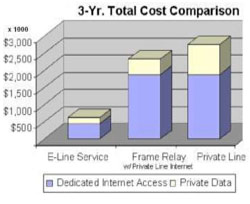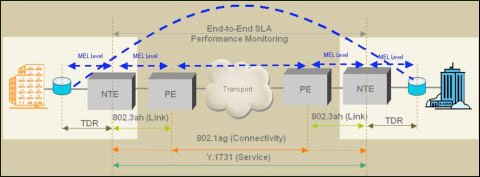
article page
| 1 | 2
| 3 |
network visibility problem. However, as we moved to newer, faster, cheaper, layer 2- and 3-based transport networks, where are all the features to support operator visibility?
One Step Back… Re-inventing the Wheel - Enhanced Network Visibility and Performance Monitoring
As customers moved to new IP/packet-based network connections, the industry needed to institute tools, processes, and methodologies to implement at least the same or better network visibility and performance monitoring requirements already available in their legacy networks. Ushering in the era of faster, cheaper pipes, IP/packet services such as Carrier Ethernet services are now delivered over fiber optics, wireless microwave, and even existing TDM copper infrastructure. Carriers and businesses are incented to displace legacy Frame Relay, ATM, and SONET/SDH business services given that the cost per bit has dropped dramatically from approximately $300/MB to under $100/MB using Carrier Ethernet, while typical 3-year costs of legacy solutions such as Private line and Frame Relay are typically five to six times more expensive than Carrier Ethernet E-Line services:

Source: Point East Research, 2007-2009
|
|
Where are all the features to support operator visibility? |
|

But while customers gobble up more bandwidth at increasingly lower costs per bit, they still require reliable five 9’s service availability, resilience, and network visibility provided by those former legacy transport technologies. Initially, SLAs, or Service Level Agreements, were used by service providers to make customers feel comfortable with new packet based offerings through guarantees for certain performance levels—no different than what had taken place 25 years ago with Ma Bell’s network.
Why the Move to “2.0”
The industry had to “reinvent” some of the tried-and-true toolsets that we use for TDM legacy networks, so in keeping with the times, we came up with a neat new buzzword emphasized by a number version such as the oft labeled “2.0” trend. Web 2.0, SAAS 2.0, Internet 2.0, so why not Carrier Ethernet 2.0? It’s not surprising that the industry needed to adopt methods to address network visibility and performance monitoring for Carrier Ethernet 2.0. The new Ethernet Operations Administration and Maintenance (OAM) standards (e.g. IEEE 802.1ag, 802.3ah, ITU Y.1731, RFC2544) were developed to address the health monitoring of customers’ Ethernet network connections.
While standards are typically drivers for carriers, the real motivation for OAM and Carrier Ethernet 2.0 may actually lie behind massive OPEX savings carriers need to bolster ROIs on their massive infrastructure upgrades to support new IP/packet-based networks and the growing list of bandwidth “hogging” applications. An interesting dilemma is that while bandwidth needs have doubled and continue to grow exponentially due to increased streaming video applications such as
|
|
|

ANDA Networks, 2009.
|
|
| |
article page
| 1
| 2
| 3 | |
|





